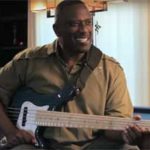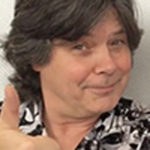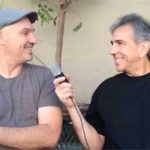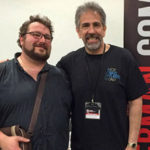In this exclusive follow-up interview, the ever-funky bassist talks about signature basses, designing amps, new releases and more!
Exclusive interview with FBPO’s Jon Liebman
May 12, 2014
Born and raised in New York City, Sekou Bunch was exposed to the arts, virtually from the very beginning. As a young child, Bunch showed great promise as a painter and dancer, both of which he pursued passionately.
Upon receiving his first bass around 1974, Bunch proved to be a quick study and soon began playing local gigs and jam sessions. At 17, Sekou teamed up with GRP artist Tom Browne, with whom he recorded the best-selling funk classic Funkin’ for Jamaica album.
Sekou eventually moved to Los Angeles, where his career picked up steam. While based in LA, Bunch toured and recorded with the late George Howard and collaborated with producers Angela Winbush and Ronald Isley and was ultimately named musical director for the Isley Brothers, a position he held for eight years.
Throughout his distinguished career, Sekou Bunch has performed and/or recorded with Quincy Jones, Rod Stewart, Stevie Wonder, Roger Daltry, Whitney Houston, Michael Jackson, Luther Vandross, Anita Baker, Ray Charles, Chaka Khan, Paul Anka, George Benson, Wayne Shorter, the Winans, Lionel Richie, Toni Braxton, Freddie Hubbard, Roberta Flack, Liza Minneli and many others. His solo CD, The Next Level, was released in 2008.
FBPO’s Jon Liebman caught up with Sekou at the 2013 gathering of Bass Player Live!
FBPO: It’s been a while since our first interview. Bring us up to date on what’s been happening.
SB: When we met last time, the Carvin SB4000 and SB5000 basses had already been launched and were gaining a lot of success among bass players. Since that time, we’ve garnered about four major industry magazine awards and I’m really proud of that. It was the beginning of my actually starting to design musical gear for bass players.
Since the success of the SB basses, I’ve designed a new bass cabinet for TecAmp called the Virtue Cab. It’s a must-see. It’s like the iPhone of bass cabinets. It does many things. It’s comprised of three tweeters, two 10s and two 12s. It has a switching panel that will allow you to change according to your environment.
FBPO: Sounds heavy!
SB: It’s very light. It’s about 57 pounds, which is lighter than an SWR cabinet and many other 4×10 cabinets. My purpose for designing it was to give options for when you’re dealing with different environments, like concrete floors, carpeted floors, hollow stages. With this configuration, you have the ability to get the right bass sound in a particular room. You can have less bass, more bass or a different quality of bass.
The tweeters have three settings. There’s an “off” position, a “high” position and a “low” position. So when you want to play some heavy rock & roll, some blues, most nuts and bolts bass, you just turn the tweeters off and you’ve just got a really thumpy bass. But when you want to do some slap techniques and bring out some of those high plucks, you have three tweeters with various options and configurations on how to work those tweeters. And if you should blow one, you don’t have to worry because you’ve got two backups! [Laughs] I love the idea and I was able to get together with TecAmp, which is in Germany, and get them to bring forth this idea. They fell in love with it and began production immediately.
FBPO: What else have you designed?
SB: I’m about to launch my own company with various accessories, like bass stands, music stands and bass straps. The bass can tend to be a heavy instrument. After playing for years, you can get problems in your shoulder, especially if you don’t have correct form. It can’t be avoided. So I designed a strap that will relieve the tension in the shoulder and I’m looking forward to bringing it to the market. I’ve also designed a bass case for traveling. As a world traveler, having traveled on many planes, I never liked worrying about whether my instrument would make it to the other side in one piece. I’ve designed a bass case that will solve that problem.
FBPO: What are you doing with all that stuff you designed? Are you making any music you want to tell us about?
SB: I’m about to launch my Michael Jackson tribute record that we’ve been working on for two years. We’re in the mixing and editing process now. It’s a “to die for” record. It has so many artists that were friends of Michael Jackson, along with new artists that never met him.
FBPO: Can you rattle off a few names for us?
SB: We’ve got Howard Hewett, the late George Duke, the late Ollie Woodson, Penny Ford, Take 6. The list is incredible. We’ve got so many people. When we’re done with the interview, I’ll start remembering more people! I’m the executive producer of the record. It’s something I wanted to do to make a contribution to the life and music of Michael Jackson. It’s scheduled to be launched sometime in 2014.
Along with that, I have two other jazz records that I’ve been working on simultaneously. Those are about to be finished too, as well as my “old school” record, which has stuff from the late ’70s and ’80s, from the Tom Browne stuff and the Sugar Hill stuff.
FBPO: You’ve been immersed in a lot of pretty major projects.
SB: Yeah, it’s a really exciting time for me. I don’t tour a whole lot with other people. I’ve done that for about thirty-five years straight, with no breaks, so this is a new area for me and it’s exciting. I have my own band and I have a record out called The Next Level that’s still gaining a lot of success and notoriety. I’m hoping to take that band out on the road throughout the country and other countries because I’m still playing. I still can play and I’m really proud of that. I’m very busy. I don’t have a problem with being busy and occupying my time.
FBPO: Keep doing what you’re doing and we’ll keep enjoying it.
SB: Here’s to “For Bass Players Only.” Thank you so much. Awesome!
Sekou’s first solo release, “The Next Level,” is available here.







